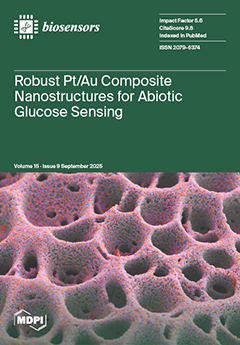Precision and real-time detection of hydrogen peroxide (H
2O
2) are essential in pharmaceutical, industrial, and defence sectors due to its strong oxidizing nature. In this study, silver (Ag)-doped CeO
2/Ag
2O-modified glassy carbon electrode (Ag-CeO
2/Ag
2
[...] Read more.
Precision and real-time detection of hydrogen peroxide (H
2O
2) are essential in pharmaceutical, industrial, and defence sectors due to its strong oxidizing nature. In this study, silver (Ag)-doped CeO
2/Ag
2O-modified glassy carbon electrode (Ag-CeO
2/Ag
2O/GCE) has been developed as a non-enzymatic electrochemical sensor for the sensitive and selective detection of H
2O
2. The synthesized Ag-doped CeO
2/Ag
2O nanocomposite was characterized using various advanced techniques, including X-ray diffraction (XRD), Fourier-transform infrared spectroscopy (FT-IR), field-emission scanning electron microscopy (FE-SEM), and high-resolution transmission electron microscopy (HR-TEM). Their optical, magnetic, thermal, and chemical properties were further analyzed using UV–vis spectroscopy, electron paramagnetic resonance (EPR), thermogravimetric-differential thermal analysis (TG-DTA), and X-ray photoelectron spectroscopy (XPS). Electrochemical sensing performance was evaluated using cyclic voltammetry and amperometry. The Ag-CeO
2/Ag
2O/GCE exhibited superior electrocatalytic activity for H
2O
2, attributed to the increased number of active sites and enhanced electron transfer. The sensor displayed a high sensitivity of 2.728 µA cm
−2 µM
−1, significantly outperforming the undoped CeO
2/GCE (0.0404 µA cm
−2 µM
−1). The limit of detection (LOD) and limit of quantification (LOQ) were found to be 6.34 µM and 21.1 µM, respectively, within a broad linear detection range of 1 × 10
−8 to 0.5 × 10
−3 M. The sensor also demonstrated excellent selectivity with minimal interference from common analytes, along with outstanding storage stability, reproducibility, and repeatability. Owing to these attributes, the Ag-CeO
2/Ag
2O/GCE sensor proved effective for real sample analysis, showcasing its potential as a reliable, non-enzymatic platform for H
2O
2 detection.
Full article






